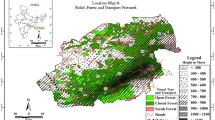Abstract—The results of this study are the first in assessing the subpopulation subdivision of the Kyrgyz horse breed. Horse genotyping was performed using 17 microsatellite loci recommended by the International Society for Animal Genetics. On the basis of the results of genotyping using the AMOVA method, paired genetic distances for horses of the Kyrgyz breed in relation to 31 other breeds were calculated. It is shown that horses of the Kyrgyz breed are genetically the closest to the Welsh pony and Warmblood horse.

Similar content being viewed by others
REFERENCES
Voronkova, V.N., Evaluation of the genetic diversity of horses from Altai—Sayan region using nuclear and mitochondrial DNA markers: Extended Abstract of Cand. Sci. Dissertation, Inst. Obshch. Genet., Moscow, 2012.
Warmuth, V., Eriksson, A., Bower, M.A., et al., European domestic horses originated in two holocene refugia, PLoS One, 2011, vol. 30, pp. 1–7. e18194. https://doi.org/10.1371/journal.pone.0018194
Livanova, T.K. and Livanova, M.A., Vse o loshadi (All about Horses), Moscow: AST-Press, 2002.
Molecular genetic characterization of animal genetic resources, FAO Animal Production and Health Guidelines, no. 9. FAO, 2011.
Stolpovskii, Yu.A., The concept and principles of genetic monitoring for the in situ conservation of domesticated animal breeds, S.-kh. Biol., 2010, no. 6, pp. 3–8.
Olsen, S.L., Early horse domestication on the Eurasian steppe, Documenting Domestication: New Genetics and Archaeological Paradigms, Zeder, M.A., Emshwiller, E., Smith, B.D., and Bradley, D.G., Eds., Univ. California Press, 2006, рр. 245–269.
Vilà, C., Leonard, J.A., Götherström, S., et al., Widespread origins of domestic horse lineages, Science, 2001, vol. 291, no. 5503, pp. 474–477. https://doi.org/10.1126/science.291.5503.474
Jansen, T., Foster, P., Levine, M.A., et al., Mitochondrial DNA and the origins of the domestic horse, Proc. Natl. Acad. Sci. U.S.A., 2002, vol. 99, no. 16, pp. 10905–10910. https://doi.org/10.1073/pnas.152330099
Ripar, Zh., Uatto, S., and Perez, S., Kyrgyzskaya loshad’, sokhraneniye i ispol’zovaniye skachki na vynoslivost’ i ekoturizm: prakticheskoye ukazaniye (Kyrgyz Horse, Conservation and Usage of Endurance Racing and Ecotourism: Practical Instruction), Bishkek, 2007.
Isakova, Zh.T., Toktosunov, B.I., Kipen’, V.N., et al., Genetic portrait of the Kyrgyz horse, Konevod. Konnyi Sport, 2018, no. 1, pp. 21–23.
Peakall, R. and Smouse, P.E., GenAlEx 6.5: genetic analysis in Excel. Population genetic software for teaching and research—an update, Bioinformatics, 2012, no. 28, pp. 2537—2539. https://doi.org/10.1093/bioinformatics/bts460
Pritchard, J.K., Stephens, M., and Donnelly, P., Inference of population structure using multilocus genotype data, Genetics, 2000, vol. 155, no. 2, pp. 945–959.
Hammer, Q., Harper, A.T., and Ryan, P.D., PAST: paleontological statistics software package for education and data analysis, Paleontol. Electron., 2001, vol. 4, no. 1, pp. 1—9.
Francis, R.M., POPHELPER: an R package and web app to analyse and visualize population structure, Mol. Ecol. Res., 2017, vol. 17, pp. 27–32. https://doi.org/10.1111/1755-0998.12509
Excoffier, L., Smouse, P.E., and Quattro, J.M., Analysis of molecular variance inferred from metric distances among DNA haplotypes: application to human mitochondrial DNA restriction data, Genetics, 1992, vol. 131, pp. 479–491.
Van De Goor, L.H.P., Panneman, H., and Van Haeringen, W.A., A proposal for standardization in forensic equine DNA typing: allele nomenclature for 17 equine-specific STR loci, Anim. Genet., 2010, vol. 41, no. 2, pp. 122–127. https://doi.org/10.1111/j.1365-2052.2009.01975.x
Zharkikh, A., Statistical properties of bootstrap estimation of phylogenetic variability from nucleotide sequences: 1. Four taxa with a molecular clock, Mol. Biol. Evol., 1992, vol. 9, no. 6, pp. 1119–1147. https://doi.org/10.1093/oxfordjournals.molbev.a040782
Author information
Authors and Affiliations
Corresponding authors
Additional information
Translated by D. Novikova
Rights and permissions
About this article
Cite this article
Isakova, Z.T., Toktosunov, B.I., Kipen, V.N. et al. Phylogenetic Analysis of Kyrgyz Horse Using 17 Microsatellite Markers. Russ J Genet 55, 100–104 (2019). https://doi.org/10.1134/S1022795419010071
Received:
Revised:
Accepted:
Published:
Issue Date:
DOI: https://doi.org/10.1134/S1022795419010071




